Advanced Medical Surgical Nursing: Emergency Case Study Report NUR330
VerifiedAdded on 2022/09/06
|7
|2154
|18
Report
AI Summary
This report analyzes an emergency nursing case study involving a patient named Gail Peters, focusing on the application of the Australasian Triage Scale (ATS), patient assessment, medication management, and patient safety within an emergency department setting. The report begins by assigning Gail an ATS category 2, based on her severe pain and potential limb-threatening condition, and recommends her placement in the pain management/trauma care area. It then justifies the need for a secondary survey and an ECG, calculating the patient's heart rate and identifying bradycardia. The focused assessment emphasizes the skeletal and cardiovascular systems, given Gail's osteoarthritis and hypertension history. The report discusses the use of Ketorolac, Paracetamol and Morphine for pain management, and highlights the risks associated with each medication. Finally, the report addresses patient safety concerns, particularly for older patients in the ED, and discusses factors contributing to prolonged stays and the importance of nurse-to-patient ratios. The report concludes by emphasizing the critical role of nurses in providing acute care and managing patient flow within the emergency department.
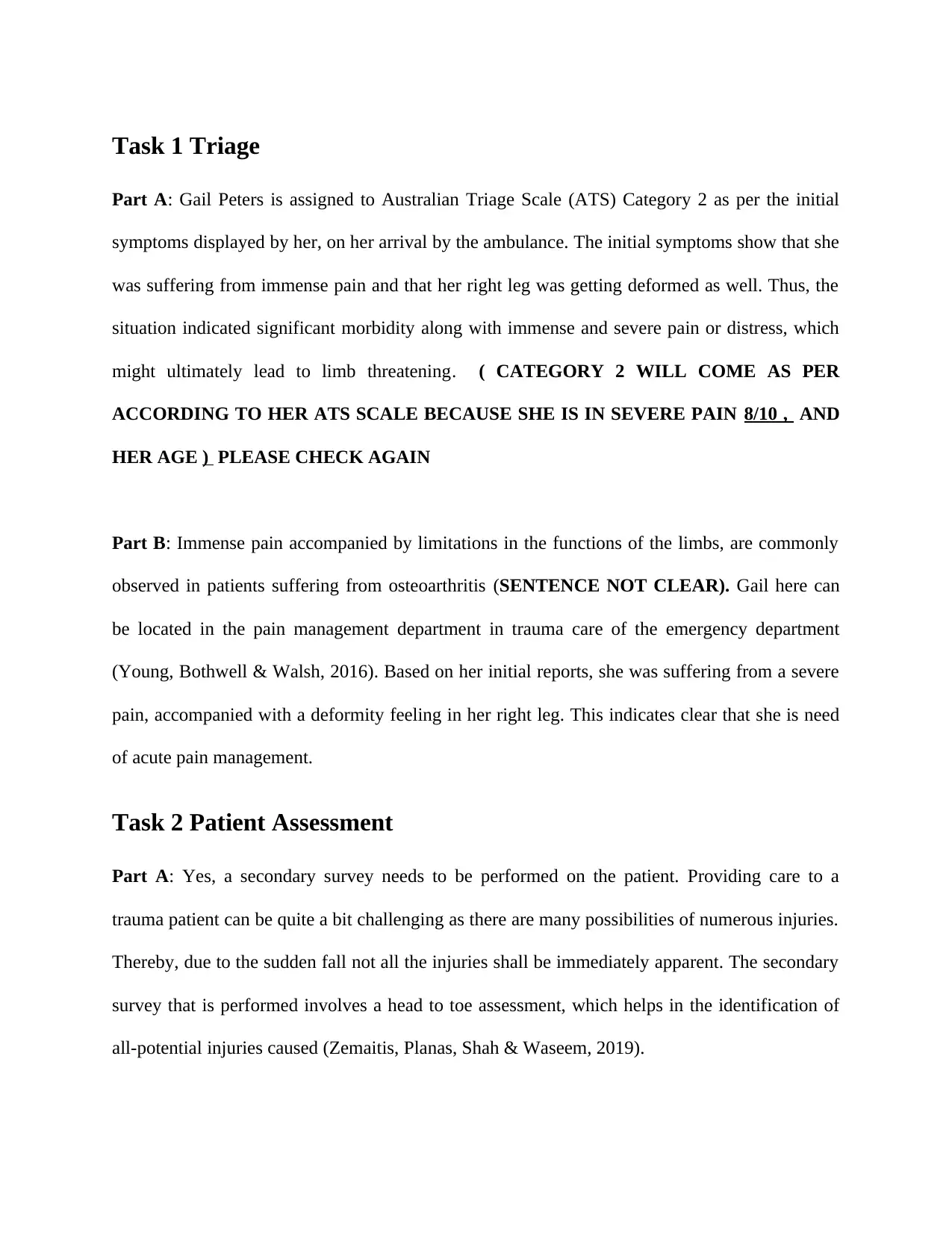
Task 1 Triage
Part A: Gail Peters is assigned to Australian Triage Scale (ATS) Category 2 as per the initial
symptoms displayed by her, on her arrival by the ambulance. The initial symptoms show that she
was suffering from immense pain and that her right leg was getting deformed as well. Thus, the
situation indicated significant morbidity along with immense and severe pain or distress, which
might ultimately lead to limb threatening. ( CATEGORY 2 WILL COME AS PER
ACCORDING TO HER ATS SCALE BECAUSE SHE IS IN SEVERE PAIN 8/10 , AND
HER AGE ) PLEASE CHECK AGAIN
Part B: Immense pain accompanied by limitations in the functions of the limbs, are commonly
observed in patients suffering from osteoarthritis (SENTENCE NOT CLEAR). Gail here can
be located in the pain management department in trauma care of the emergency department
(Young, Bothwell & Walsh, 2016). Based on her initial reports, she was suffering from a severe
pain, accompanied with a deformity feeling in her right leg. This indicates clear that she is need
of acute pain management.
Task 2 Patient Assessment
Part A: Yes, a secondary survey needs to be performed on the patient. Providing care to a
trauma patient can be quite a bit challenging as there are many possibilities of numerous injuries.
Thereby, due to the sudden fall not all the injuries shall be immediately apparent. The secondary
survey that is performed involves a head to toe assessment, which helps in the identification of
all-potential injuries caused (Zemaitis, Planas, Shah & Waseem, 2019).
Part A: Gail Peters is assigned to Australian Triage Scale (ATS) Category 2 as per the initial
symptoms displayed by her, on her arrival by the ambulance. The initial symptoms show that she
was suffering from immense pain and that her right leg was getting deformed as well. Thus, the
situation indicated significant morbidity along with immense and severe pain or distress, which
might ultimately lead to limb threatening. ( CATEGORY 2 WILL COME AS PER
ACCORDING TO HER ATS SCALE BECAUSE SHE IS IN SEVERE PAIN 8/10 , AND
HER AGE ) PLEASE CHECK AGAIN
Part B: Immense pain accompanied by limitations in the functions of the limbs, are commonly
observed in patients suffering from osteoarthritis (SENTENCE NOT CLEAR). Gail here can
be located in the pain management department in trauma care of the emergency department
(Young, Bothwell & Walsh, 2016). Based on her initial reports, she was suffering from a severe
pain, accompanied with a deformity feeling in her right leg. This indicates clear that she is need
of acute pain management.
Task 2 Patient Assessment
Part A: Yes, a secondary survey needs to be performed on the patient. Providing care to a
trauma patient can be quite a bit challenging as there are many possibilities of numerous injuries.
Thereby, due to the sudden fall not all the injuries shall be immediately apparent. The secondary
survey that is performed involves a head to toe assessment, which helps in the identification of
all-potential injuries caused (Zemaitis, Planas, Shah & Waseem, 2019).
Paraphrase This Document
Need a fresh take? Get an instant paraphrase of this document with our AI Paraphraser
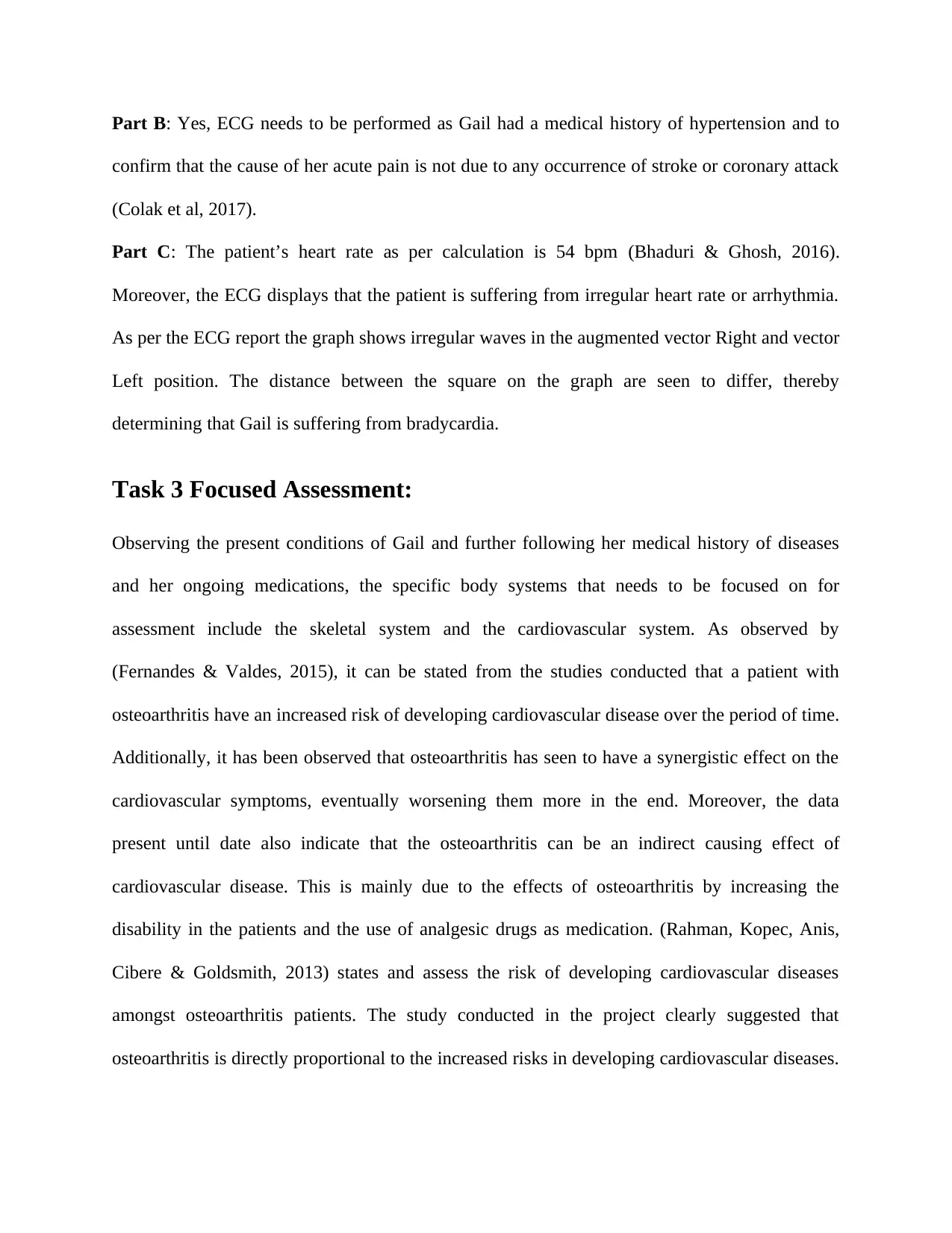
Part B: Yes, ECG needs to be performed as Gail had a medical history of hypertension and to
confirm that the cause of her acute pain is not due to any occurrence of stroke or coronary attack
(Colak et al, 2017).
Part C: The patient’s heart rate as per calculation is 54 bpm (Bhaduri & Ghosh, 2016).
Moreover, the ECG displays that the patient is suffering from irregular heart rate or arrhythmia.
As per the ECG report the graph shows irregular waves in the augmented vector Right and vector
Left position. The distance between the square on the graph are seen to differ, thereby
determining that Gail is suffering from bradycardia.
Task 3 Focused Assessment:
Observing the present conditions of Gail and further following her medical history of diseases
and her ongoing medications, the specific body systems that needs to be focused on for
assessment include the skeletal system and the cardiovascular system. As observed by
(Fernandes & Valdes, 2015), it can be stated from the studies conducted that a patient with
osteoarthritis have an increased risk of developing cardiovascular disease over the period of time.
Additionally, it has been observed that osteoarthritis has seen to have a synergistic effect on the
cardiovascular symptoms, eventually worsening them more in the end. Moreover, the data
present until date also indicate that the osteoarthritis can be an indirect causing effect of
cardiovascular disease. This is mainly due to the effects of osteoarthritis by increasing the
disability in the patients and the use of analgesic drugs as medication. (Rahman, Kopec, Anis,
Cibere & Goldsmith, 2013) states and assess the risk of developing cardiovascular diseases
amongst osteoarthritis patients. The study conducted in the project clearly suggested that
osteoarthritis is directly proportional to the increased risks in developing cardiovascular diseases.
confirm that the cause of her acute pain is not due to any occurrence of stroke or coronary attack
(Colak et al, 2017).
Part C: The patient’s heart rate as per calculation is 54 bpm (Bhaduri & Ghosh, 2016).
Moreover, the ECG displays that the patient is suffering from irregular heart rate or arrhythmia.
As per the ECG report the graph shows irregular waves in the augmented vector Right and vector
Left position. The distance between the square on the graph are seen to differ, thereby
determining that Gail is suffering from bradycardia.
Task 3 Focused Assessment:
Observing the present conditions of Gail and further following her medical history of diseases
and her ongoing medications, the specific body systems that needs to be focused on for
assessment include the skeletal system and the cardiovascular system. As observed by
(Fernandes & Valdes, 2015), it can be stated from the studies conducted that a patient with
osteoarthritis have an increased risk of developing cardiovascular disease over the period of time.
Additionally, it has been observed that osteoarthritis has seen to have a synergistic effect on the
cardiovascular symptoms, eventually worsening them more in the end. Moreover, the data
present until date also indicate that the osteoarthritis can be an indirect causing effect of
cardiovascular disease. This is mainly due to the effects of osteoarthritis by increasing the
disability in the patients and the use of analgesic drugs as medication. (Rahman, Kopec, Anis,
Cibere & Goldsmith, 2013) states and assess the risk of developing cardiovascular diseases
amongst osteoarthritis patients. The study conducted in the project clearly suggested that
osteoarthritis is directly proportional to the increased risks in developing cardiovascular diseases.
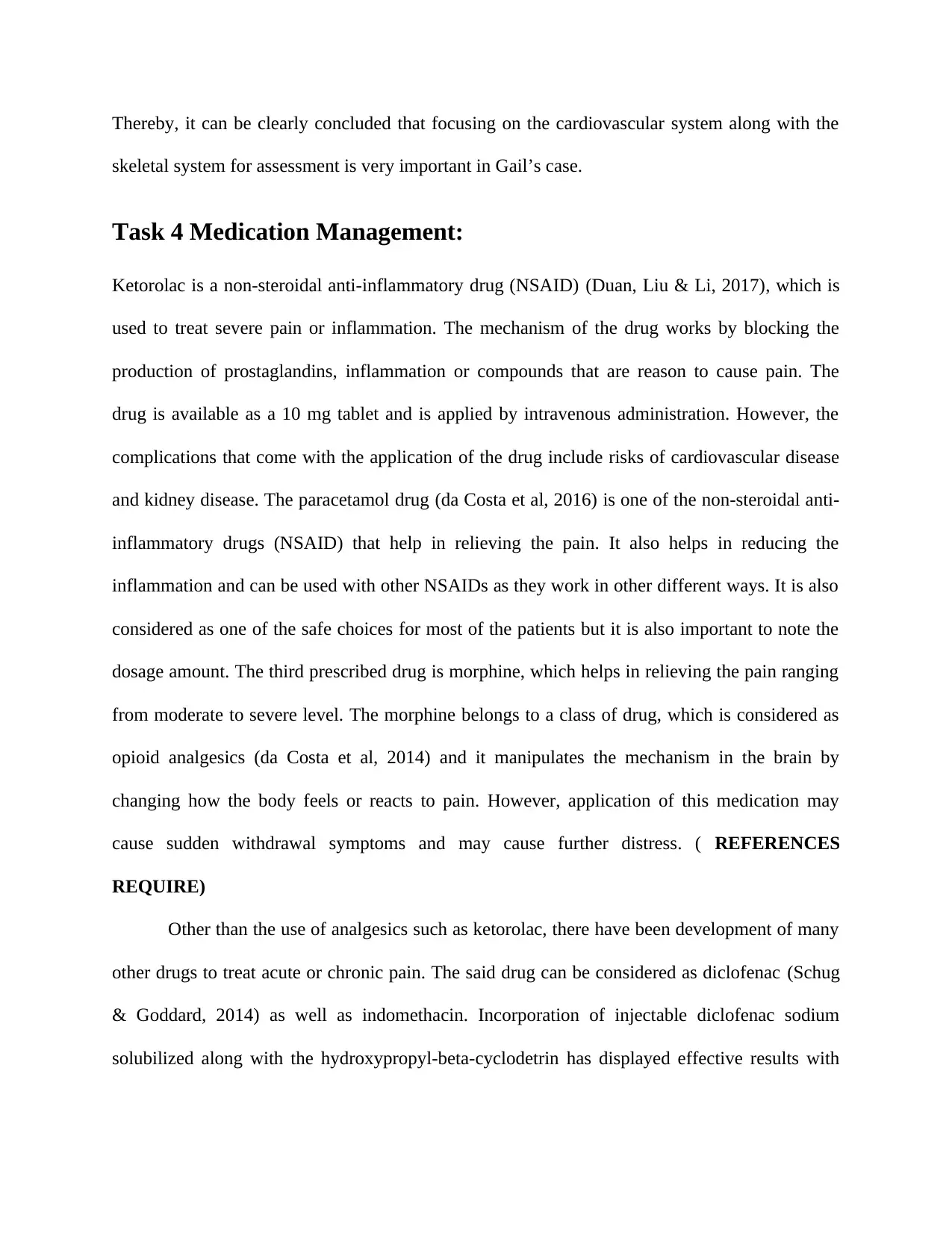
Thereby, it can be clearly concluded that focusing on the cardiovascular system along with the
skeletal system for assessment is very important in Gail’s case.
Task 4 Medication Management:
Ketorolac is a non-steroidal anti-inflammatory drug (NSAID) (Duan, Liu & Li, 2017), which is
used to treat severe pain or inflammation. The mechanism of the drug works by blocking the
production of prostaglandins, inflammation or compounds that are reason to cause pain. The
drug is available as a 10 mg tablet and is applied by intravenous administration. However, the
complications that come with the application of the drug include risks of cardiovascular disease
and kidney disease. The paracetamol drug (da Costa et al, 2016) is one of the non-steroidal anti-
inflammatory drugs (NSAID) that help in relieving the pain. It also helps in reducing the
inflammation and can be used with other NSAIDs as they work in other different ways. It is also
considered as one of the safe choices for most of the patients but it is also important to note the
dosage amount. The third prescribed drug is morphine, which helps in relieving the pain ranging
from moderate to severe level. The morphine belongs to a class of drug, which is considered as
opioid analgesics (da Costa et al, 2014) and it manipulates the mechanism in the brain by
changing how the body feels or reacts to pain. However, application of this medication may
cause sudden withdrawal symptoms and may cause further distress. ( REFERENCES
REQUIRE)
Other than the use of analgesics such as ketorolac, there have been development of many
other drugs to treat acute or chronic pain. The said drug can be considered as diclofenac (Schug
& Goddard, 2014) as well as indomethacin. Incorporation of injectable diclofenac sodium
solubilized along with the hydroxypropyl-beta-cyclodetrin has displayed effective results with
skeletal system for assessment is very important in Gail’s case.
Task 4 Medication Management:
Ketorolac is a non-steroidal anti-inflammatory drug (NSAID) (Duan, Liu & Li, 2017), which is
used to treat severe pain or inflammation. The mechanism of the drug works by blocking the
production of prostaglandins, inflammation or compounds that are reason to cause pain. The
drug is available as a 10 mg tablet and is applied by intravenous administration. However, the
complications that come with the application of the drug include risks of cardiovascular disease
and kidney disease. The paracetamol drug (da Costa et al, 2016) is one of the non-steroidal anti-
inflammatory drugs (NSAID) that help in relieving the pain. It also helps in reducing the
inflammation and can be used with other NSAIDs as they work in other different ways. It is also
considered as one of the safe choices for most of the patients but it is also important to note the
dosage amount. The third prescribed drug is morphine, which helps in relieving the pain ranging
from moderate to severe level. The morphine belongs to a class of drug, which is considered as
opioid analgesics (da Costa et al, 2014) and it manipulates the mechanism in the brain by
changing how the body feels or reacts to pain. However, application of this medication may
cause sudden withdrawal symptoms and may cause further distress. ( REFERENCES
REQUIRE)
Other than the use of analgesics such as ketorolac, there have been development of many
other drugs to treat acute or chronic pain. The said drug can be considered as diclofenac (Schug
& Goddard, 2014) as well as indomethacin. Incorporation of injectable diclofenac sodium
solubilized along with the hydroxypropyl-beta-cyclodetrin has displayed effective results with
⊘ This is a preview!⊘
Do you want full access?
Subscribe today to unlock all pages.

Trusted by 1+ million students worldwide
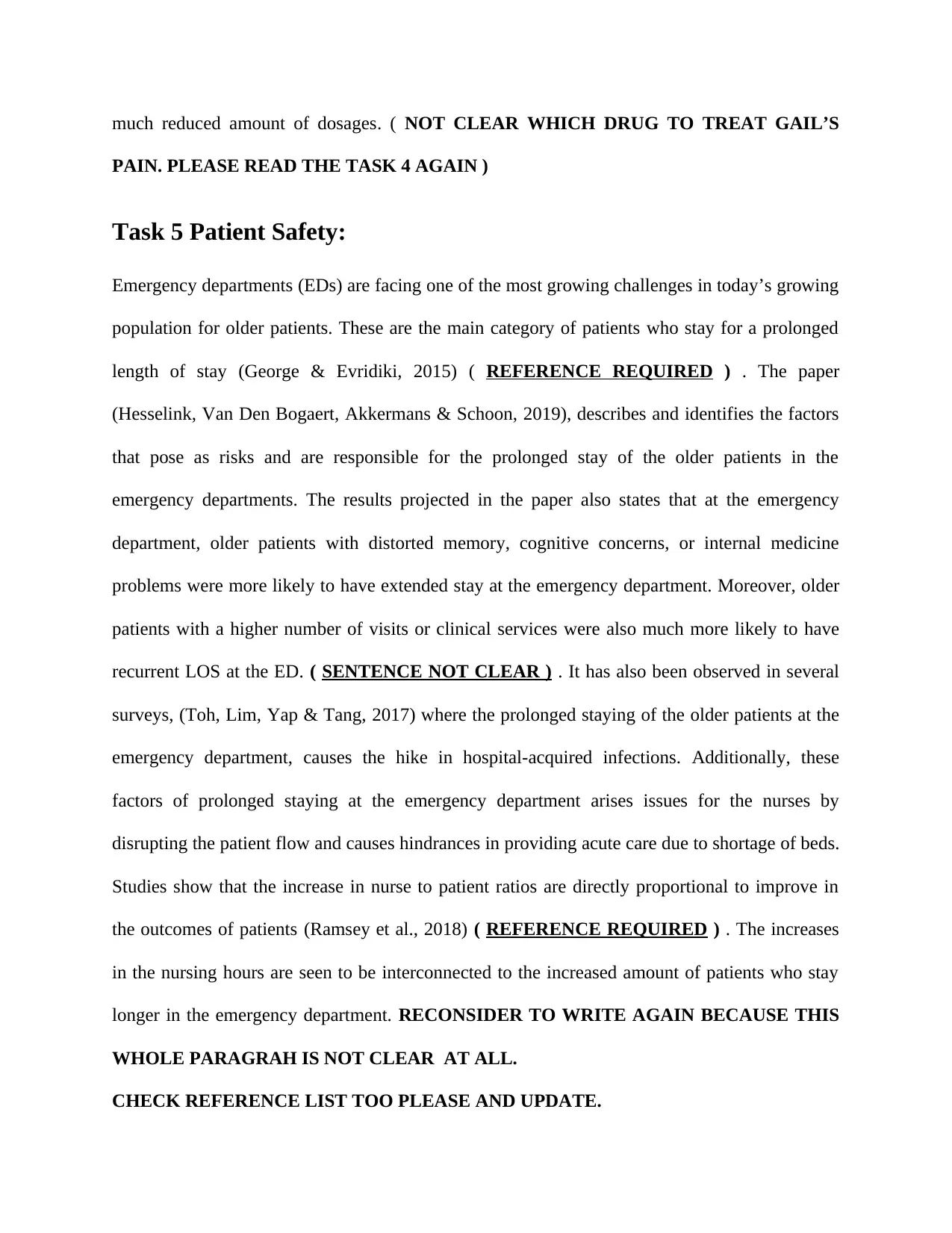
much reduced amount of dosages. ( NOT CLEAR WHICH DRUG TO TREAT GAIL’S
PAIN. PLEASE READ THE TASK 4 AGAIN )
Task 5 Patient Safety:
Emergency departments (EDs) are facing one of the most growing challenges in today’s growing
population for older patients. These are the main category of patients who stay for a prolonged
length of stay (George & Evridiki, 2015) ( REFERENCE REQUIRED ) . The paper
(Hesselink, Van Den Bogaert, Akkermans & Schoon, 2019), describes and identifies the factors
that pose as risks and are responsible for the prolonged stay of the older patients in the
emergency departments. The results projected in the paper also states that at the emergency
department, older patients with distorted memory, cognitive concerns, or internal medicine
problems were more likely to have extended stay at the emergency department. Moreover, older
patients with a higher number of visits or clinical services were also much more likely to have
recurrent LOS at the ED. ( SENTENCE NOT CLEAR ) . It has also been observed in several
surveys, (Toh, Lim, Yap & Tang, 2017) where the prolonged staying of the older patients at the
emergency department, causes the hike in hospital-acquired infections. Additionally, these
factors of prolonged staying at the emergency department arises issues for the nurses by
disrupting the patient flow and causes hindrances in providing acute care due to shortage of beds.
Studies show that the increase in nurse to patient ratios are directly proportional to improve in
the outcomes of patients (Ramsey et al., 2018) ( REFERENCE REQUIRED ) . The increases
in the nursing hours are seen to be interconnected to the increased amount of patients who stay
longer in the emergency department. RECONSIDER TO WRITE AGAIN BECAUSE THIS
WHOLE PARAGRAH IS NOT CLEAR AT ALL.
CHECK REFERENCE LIST TOO PLEASE AND UPDATE.
PAIN. PLEASE READ THE TASK 4 AGAIN )
Task 5 Patient Safety:
Emergency departments (EDs) are facing one of the most growing challenges in today’s growing
population for older patients. These are the main category of patients who stay for a prolonged
length of stay (George & Evridiki, 2015) ( REFERENCE REQUIRED ) . The paper
(Hesselink, Van Den Bogaert, Akkermans & Schoon, 2019), describes and identifies the factors
that pose as risks and are responsible for the prolonged stay of the older patients in the
emergency departments. The results projected in the paper also states that at the emergency
department, older patients with distorted memory, cognitive concerns, or internal medicine
problems were more likely to have extended stay at the emergency department. Moreover, older
patients with a higher number of visits or clinical services were also much more likely to have
recurrent LOS at the ED. ( SENTENCE NOT CLEAR ) . It has also been observed in several
surveys, (Toh, Lim, Yap & Tang, 2017) where the prolonged staying of the older patients at the
emergency department, causes the hike in hospital-acquired infections. Additionally, these
factors of prolonged staying at the emergency department arises issues for the nurses by
disrupting the patient flow and causes hindrances in providing acute care due to shortage of beds.
Studies show that the increase in nurse to patient ratios are directly proportional to improve in
the outcomes of patients (Ramsey et al., 2018) ( REFERENCE REQUIRED ) . The increases
in the nursing hours are seen to be interconnected to the increased amount of patients who stay
longer in the emergency department. RECONSIDER TO WRITE AGAIN BECAUSE THIS
WHOLE PARAGRAH IS NOT CLEAR AT ALL.
CHECK REFERENCE LIST TOO PLEASE AND UPDATE.
Paraphrase This Document
Need a fresh take? Get an instant paraphrase of this document with our AI Paraphraser
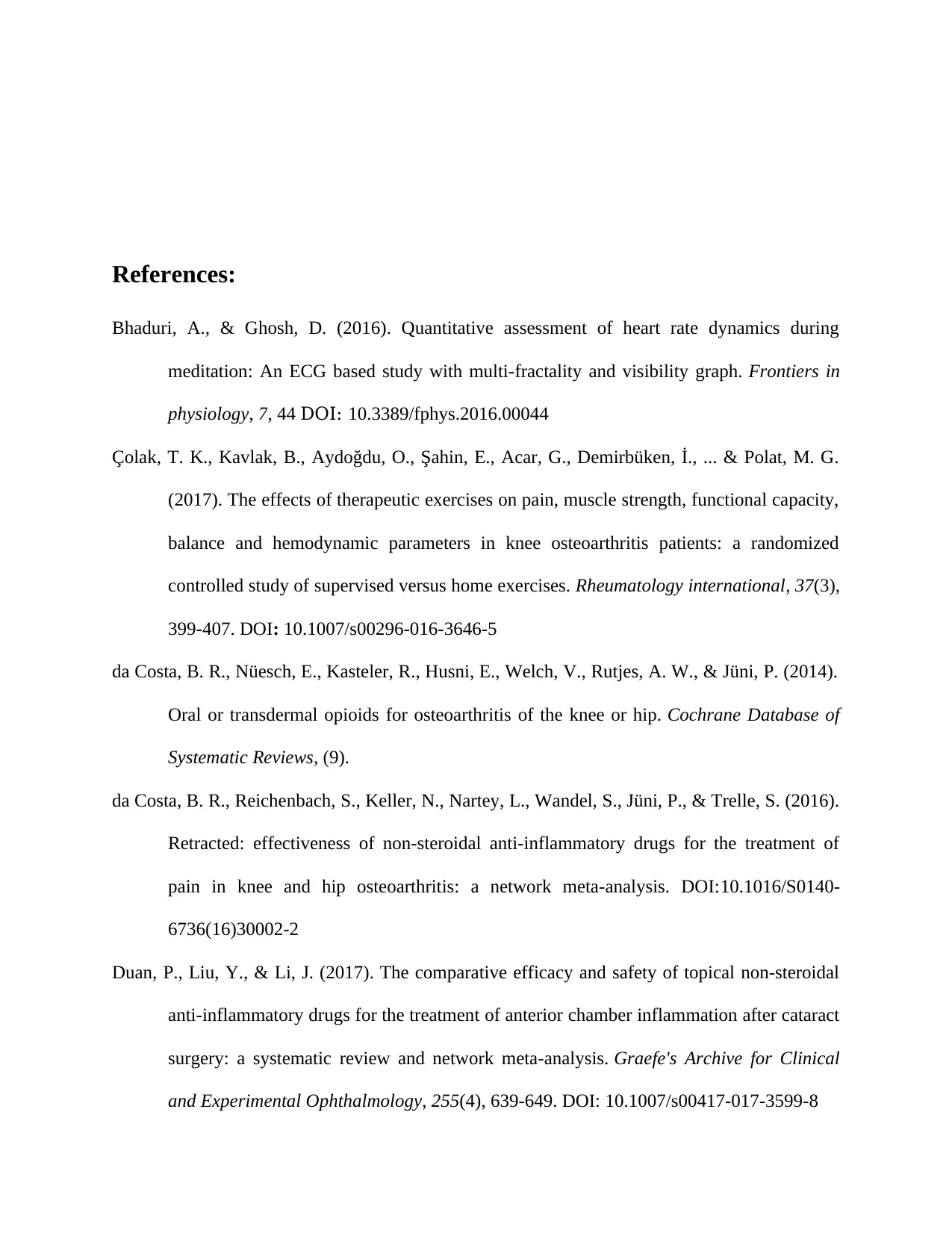
References:
Bhaduri, A., & Ghosh, D. (2016). Quantitative assessment of heart rate dynamics during
meditation: An ECG based study with multi-fractality and visibility graph. Frontiers in
physiology, 7, 44 DOI: 10.3389/fphys.2016.00044
Çolak, T. K., Kavlak, B., Aydoğdu, O., Şahin, E., Acar, G., Demirbüken, İ., ... & Polat, M. G.
(2017). The effects of therapeutic exercises on pain, muscle strength, functional capacity,
balance and hemodynamic parameters in knee osteoarthritis patients: a randomized
controlled study of supervised versus home exercises. Rheumatology international, 37(3),
399-407. DOI: 10.1007/s00296-016-3646-5
da Costa, B. R., Nüesch, E., Kasteler, R., Husni, E., Welch, V., Rutjes, A. W., & Jüni, P. (2014).
Oral or transdermal opioids for osteoarthritis of the knee or hip. Cochrane Database of
Systematic Reviews, (9).
da Costa, B. R., Reichenbach, S., Keller, N., Nartey, L., Wandel, S., Jüni, P., & Trelle, S. (2016).
Retracted: effectiveness of non-steroidal anti-inflammatory drugs for the treatment of
pain in knee and hip osteoarthritis: a network meta-analysis. DOI:10.1016/S0140-
6736(16)30002-2
Duan, P., Liu, Y., & Li, J. (2017). The comparative efficacy and safety of topical non-steroidal
anti-inflammatory drugs for the treatment of anterior chamber inflammation after cataract
surgery: a systematic review and network meta-analysis. Graefe's Archive for Clinical
and Experimental Ophthalmology, 255(4), 639-649. DOI: 10.1007/s00417-017-3599-8
Bhaduri, A., & Ghosh, D. (2016). Quantitative assessment of heart rate dynamics during
meditation: An ECG based study with multi-fractality and visibility graph. Frontiers in
physiology, 7, 44 DOI: 10.3389/fphys.2016.00044
Çolak, T. K., Kavlak, B., Aydoğdu, O., Şahin, E., Acar, G., Demirbüken, İ., ... & Polat, M. G.
(2017). The effects of therapeutic exercises on pain, muscle strength, functional capacity,
balance and hemodynamic parameters in knee osteoarthritis patients: a randomized
controlled study of supervised versus home exercises. Rheumatology international, 37(3),
399-407. DOI: 10.1007/s00296-016-3646-5
da Costa, B. R., Nüesch, E., Kasteler, R., Husni, E., Welch, V., Rutjes, A. W., & Jüni, P. (2014).
Oral or transdermal opioids for osteoarthritis of the knee or hip. Cochrane Database of
Systematic Reviews, (9).
da Costa, B. R., Reichenbach, S., Keller, N., Nartey, L., Wandel, S., Jüni, P., & Trelle, S. (2016).
Retracted: effectiveness of non-steroidal anti-inflammatory drugs for the treatment of
pain in knee and hip osteoarthritis: a network meta-analysis. DOI:10.1016/S0140-
6736(16)30002-2
Duan, P., Liu, Y., & Li, J. (2017). The comparative efficacy and safety of topical non-steroidal
anti-inflammatory drugs for the treatment of anterior chamber inflammation after cataract
surgery: a systematic review and network meta-analysis. Graefe's Archive for Clinical
and Experimental Ophthalmology, 255(4), 639-649. DOI: 10.1007/s00417-017-3599-8
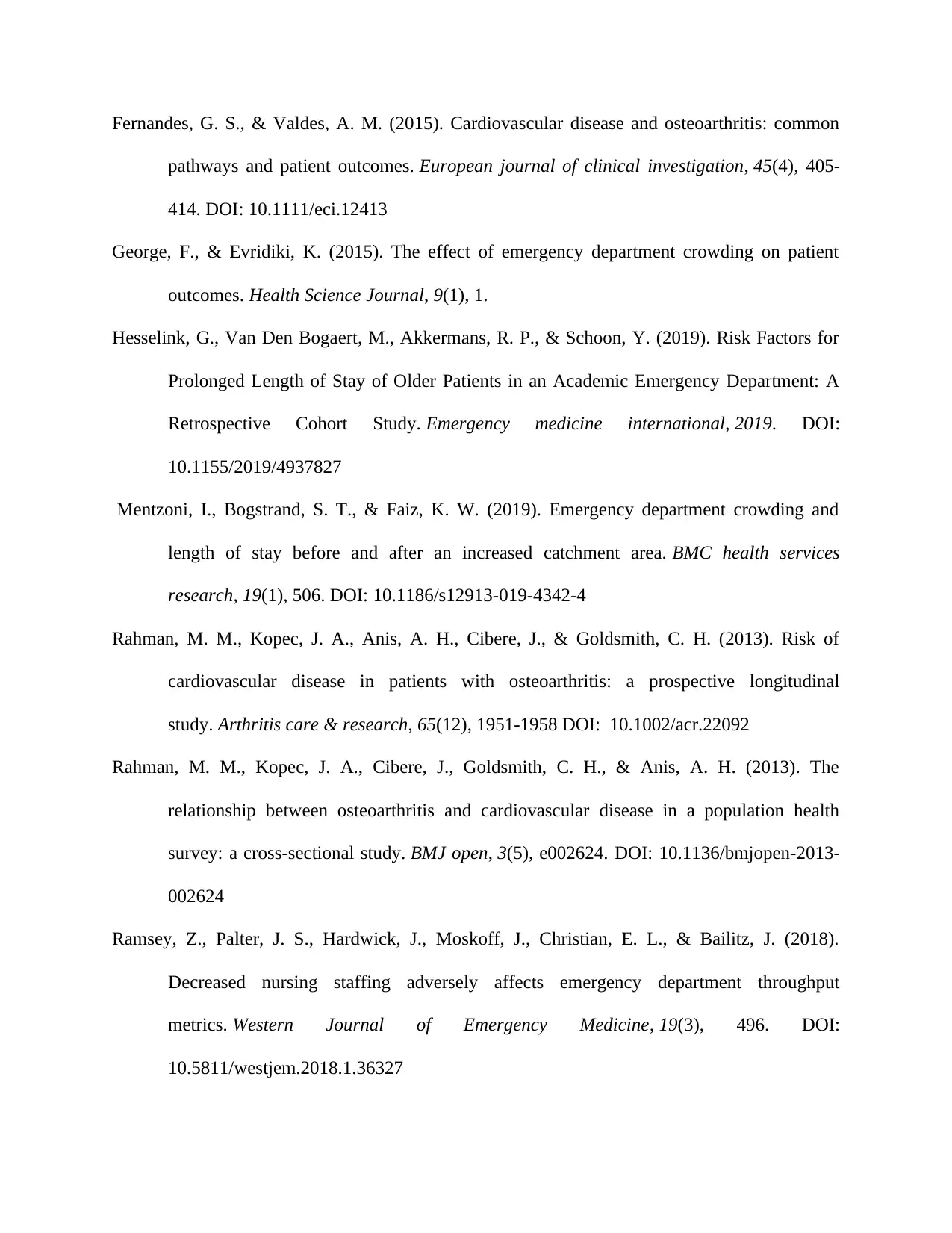
Fernandes, G. S., & Valdes, A. M. (2015). Cardiovascular disease and osteoarthritis: common
pathways and patient outcomes. European journal of clinical investigation, 45(4), 405-
414. DOI: 10.1111/eci.12413
George, F., & Evridiki, K. (2015). The effect of emergency department crowding on patient
outcomes. Health Science Journal, 9(1), 1.
Hesselink, G., Van Den Bogaert, M., Akkermans, R. P., & Schoon, Y. (2019). Risk Factors for
Prolonged Length of Stay of Older Patients in an Academic Emergency Department: A
Retrospective Cohort Study. Emergency medicine international, 2019. DOI:
10.1155/2019/4937827
Mentzoni, I., Bogstrand, S. T., & Faiz, K. W. (2019). Emergency department crowding and
length of stay before and after an increased catchment area. BMC health services
research, 19(1), 506. DOI: 10.1186/s12913-019-4342-4
Rahman, M. M., Kopec, J. A., Anis, A. H., Cibere, J., & Goldsmith, C. H. (2013). Risk of
cardiovascular disease in patients with osteoarthritis: a prospective longitudinal
study. Arthritis care & research, 65(12), 1951-1958 DOI: 10.1002/acr.22092
Rahman, M. M., Kopec, J. A., Cibere, J., Goldsmith, C. H., & Anis, A. H. (2013). The
relationship between osteoarthritis and cardiovascular disease in a population health
survey: a cross-sectional study. BMJ open, 3(5), e002624. DOI: 10.1136/bmjopen-2013-
002624
Ramsey, Z., Palter, J. S., Hardwick, J., Moskoff, J., Christian, E. L., & Bailitz, J. (2018).
Decreased nursing staffing adversely affects emergency department throughput
metrics. Western Journal of Emergency Medicine, 19(3), 496. DOI:
10.5811/westjem.2018.1.36327
pathways and patient outcomes. European journal of clinical investigation, 45(4), 405-
414. DOI: 10.1111/eci.12413
George, F., & Evridiki, K. (2015). The effect of emergency department crowding on patient
outcomes. Health Science Journal, 9(1), 1.
Hesselink, G., Van Den Bogaert, M., Akkermans, R. P., & Schoon, Y. (2019). Risk Factors for
Prolonged Length of Stay of Older Patients in an Academic Emergency Department: A
Retrospective Cohort Study. Emergency medicine international, 2019. DOI:
10.1155/2019/4937827
Mentzoni, I., Bogstrand, S. T., & Faiz, K. W. (2019). Emergency department crowding and
length of stay before and after an increased catchment area. BMC health services
research, 19(1), 506. DOI: 10.1186/s12913-019-4342-4
Rahman, M. M., Kopec, J. A., Anis, A. H., Cibere, J., & Goldsmith, C. H. (2013). Risk of
cardiovascular disease in patients with osteoarthritis: a prospective longitudinal
study. Arthritis care & research, 65(12), 1951-1958 DOI: 10.1002/acr.22092
Rahman, M. M., Kopec, J. A., Cibere, J., Goldsmith, C. H., & Anis, A. H. (2013). The
relationship between osteoarthritis and cardiovascular disease in a population health
survey: a cross-sectional study. BMJ open, 3(5), e002624. DOI: 10.1136/bmjopen-2013-
002624
Ramsey, Z., Palter, J. S., Hardwick, J., Moskoff, J., Christian, E. L., & Bailitz, J. (2018).
Decreased nursing staffing adversely affects emergency department throughput
metrics. Western Journal of Emergency Medicine, 19(3), 496. DOI:
10.5811/westjem.2018.1.36327
⊘ This is a preview!⊘
Do you want full access?
Subscribe today to unlock all pages.

Trusted by 1+ million students worldwide
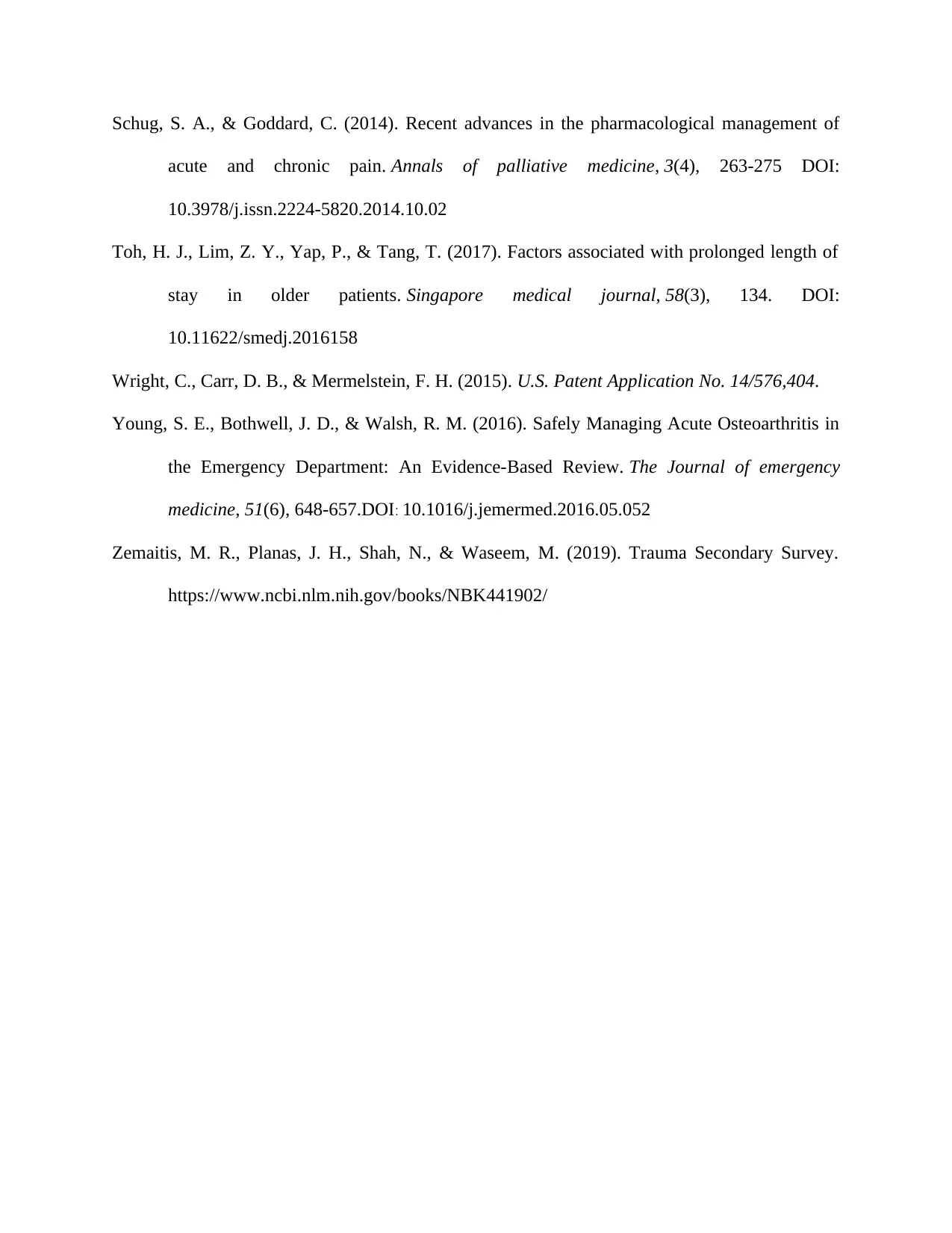
Schug, S. A., & Goddard, C. (2014). Recent advances in the pharmacological management of
acute and chronic pain. Annals of palliative medicine, 3(4), 263-275 DOI:
10.3978/j.issn.2224-5820.2014.10.02
Toh, H. J., Lim, Z. Y., Yap, P., & Tang, T. (2017). Factors associated with prolonged length of
stay in older patients. Singapore medical journal, 58(3), 134. DOI:
10.11622/smedj.2016158
Wright, C., Carr, D. B., & Mermelstein, F. H. (2015). U.S. Patent Application No. 14/576,404.
Young, S. E., Bothwell, J. D., & Walsh, R. M. (2016). Safely Managing Acute Osteoarthritis in
the Emergency Department: An Evidence-Based Review. The Journal of emergency
medicine, 51(6), 648-657.DOI: 10.1016/j.jemermed.2016.05.052
Zemaitis, M. R., Planas, J. H., Shah, N., & Waseem, M. (2019). Trauma Secondary Survey.
https://www.ncbi.nlm.nih.gov/books/NBK441902/
acute and chronic pain. Annals of palliative medicine, 3(4), 263-275 DOI:
10.3978/j.issn.2224-5820.2014.10.02
Toh, H. J., Lim, Z. Y., Yap, P., & Tang, T. (2017). Factors associated with prolonged length of
stay in older patients. Singapore medical journal, 58(3), 134. DOI:
10.11622/smedj.2016158
Wright, C., Carr, D. B., & Mermelstein, F. H. (2015). U.S. Patent Application No. 14/576,404.
Young, S. E., Bothwell, J. D., & Walsh, R. M. (2016). Safely Managing Acute Osteoarthritis in
the Emergency Department: An Evidence-Based Review. The Journal of emergency
medicine, 51(6), 648-657.DOI: 10.1016/j.jemermed.2016.05.052
Zemaitis, M. R., Planas, J. H., Shah, N., & Waseem, M. (2019). Trauma Secondary Survey.
https://www.ncbi.nlm.nih.gov/books/NBK441902/
1 out of 7
Related Documents
Your All-in-One AI-Powered Toolkit for Academic Success.
+13062052269
info@desklib.com
Available 24*7 on WhatsApp / Email
![[object Object]](/_next/static/media/star-bottom.7253800d.svg)
Unlock your academic potential
Copyright © 2020–2025 A2Z Services. All Rights Reserved. Developed and managed by ZUCOL.




